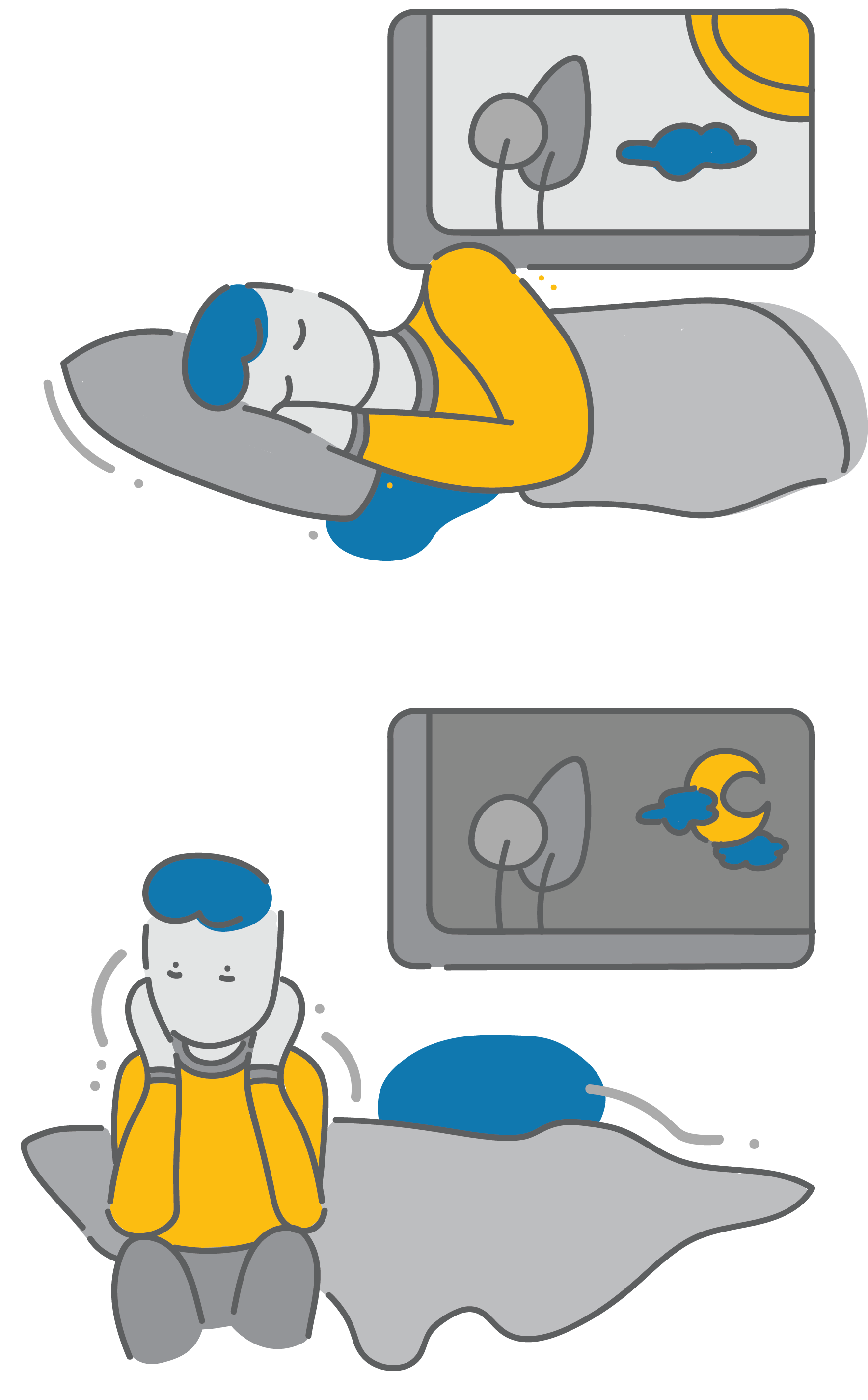Symptom Areas
Sleep
Updated Aug 2, 2019
Swipe right to go to the next slide
Sleep difficulties are common during recovery, with more than half of people reporting sleep disturbances after a concussion. Sleep difficulties generally improve over time.
In the early stages of recovery, you may need more sleep; this is normal and will gradually improve over time.
You may be having difficulty falling asleep, staying asleep, or getting a restful sleep. Sleep hygiene strategies can help promote healthy sleep patterns.

It’s helpful to think of sleep difficulties as a 24-hour problem, not just a nighttime problem. What you do during the day can impact your sleep-wake cycle.
Our brains are hardwired to need sleep. This need is managed by our body clock and our sleep drive system. Our body clock, or circadian rhythm, controls when our body and brain are ready for sleep or wakefulness. This means that when you sleep (nighttime or daytime) matters.
Our sleep drive system balances our sleep and wakeful periods. Your sleep drive starts to build when you wake up. The more you do, the stronger it becomes. You may find it harder to fall asleep on a day you spent resting without enough activity to build your sleep drive.
After a poor sleep, you may feel the need to nap the next day. However, if the nap becomes too long, or happens too late in the day, it can decrease your sleep drive and interfere with your sleep that night. This can create a cycle that worsens sleep difficulties. Prioritize your sleep at night.
If you are sleepy and can’t avoid a nap, limit napping to:

You may find it harder to fall asleep after a busy day. Remember, sleep difficulties are a 24-hour problem.
Give yourself at least an hour to wind down after being active during the day. Often called a “buffer zone”, this can make it easier to fall asleep once you go to bed. You may need a longer “buffer zone” after a busy day. Do an activity you find easy and enjoyable.
Consider what activities might work for you. Light reading? Listening to music? Gentle yoga or stretching?
Avoid activities that are very engaging or goal driven, such as projects, exciting movies, chores, or planning.
Limit the time you spend awake in bed. If you are spending long periods of time in bed not sleeping, this can create an association of your bed as a place that it is hard to fall asleep.
If you are lying in bed and it is obvious that you will be unable to fall asleep anytime soon, get out of bedroom and go to a different room (or different spot in the room if it is a one room space). Find a comfortable spot to engage in a quiet, “mindless” type of activity.
There is no “one size fits all” activity that will work for everyone. Consider activities that you find enjoyable and relaxing. Avoid bright lights and activities that make you feel more alert. Return to bed only once you feel sleepy.
If you are chronically sleep deprived, it can take time to gradually normalize your sleep cycle. If sleep is not improving after 4 weeks of using sleep hygiene strategies, talk to your family doctor. Your family doctor can assess for other medical conditions that can impact sleep, and recommend additional treatment. More information on addressing sleep can be found on a patient information sheet from the Living Concussion Guidelines here [pdf].
If you have sleep difficulties at least three nights per week, for over three months, talk to your family doctor or a psychologist to see if you suffer from insomnia. The ONF recommends Cognitive Behavioural Therapy for insomnia (CBTi) as an evidence based treatment for insomnia following a concussion.
If you have been diagnosed with insomnia, ask your family doctor or psychologist if CBTi is right for you. If a healthcare provider with CBTi training is not available, your family doctor may be able to help you implement some components of the CBTi model. The following resources offer a self-help approach to CBTi:
Books:
You’ve just learned about a number of strategies that can help you sleep better.
Take a moment to create an Action Plan!
If you’re not sure where to start, make an appointment to talk to your family doctor about your sleep difficulties. Tracking your sleep with a sleep diary [pdf] for 1-2 weeks may be helpful.
More info on Re-Creating a Time and Place for Sleep is available from the Living Concussion Guidelines [pdf].

A sleep hygiene strategy you may want to take action on is getting daily exercise. See our article on Exercise for helpful tips on getting started.
The Pacing, Brain Breaks, and Stress Management articles go over strategies can help you manage your daytime fatigue. Check out those articles in the Becoming a Self-Manager section.
Need ideas for a relaxation exercise? Take a look at these free resources from Anxiety Canada:
Click the button above to toggle between light mode and dark mode. This toggle can also be found in the menu.
Hold
and tap
to zoom in.
Hold
and tap
to zoom out.
Hold
and tap
to zoom in.
Hold
and tap
to zoom out.
On most mobile devices, you can spread to zoom.
Increase your text size in your device settings.
Remember to take regular breaks while exploring MyGuide: Concussion.
Vancouver Coastal Health’s MyGuide Concussion Team would love to hear your feedback! It matters to us and helps to improve the experience for future users. Your responses will be kept anonymous and your privacy is a top priority. To complete a 15-20 minute online survey or request a telephone survey, please click the link below.